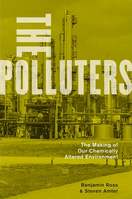“The Polluters” reveals the history of industrial pollution
When I was a teenager, my mother worked at a chemical plant in Wilmington, Delaware. When she told me about her work, she emphasized the safety procedures that the plant followed. Many of the procedures were due to the ongoing environmental cleanup in and around the site. Before 1970, there was little in the way of environmental standards for industrial sites in the United States.
The Polluters: The Making of Our Chemically Altered Environment, by Ben Ross and Steven Amter, explains in an accessible way the lack of environmental controls in the chemical industry from its earliest activities in the 19th century until circa 1970.
Ross is also the president of the Action Committee for Transit, Montgomery County’s transit advocacy organization. Disclosure: I am a board member in ACT.
While it’s easy to envision an “evil corporation preying on the common man” storyline, the truth is more nuanced. Ross and Amter show that throughout the first two thirds of the 20th century, there was a consistent debate and struggle between individuals both inside and outside industry. Many favored comprehensive national environmental standards, while a surprisingly small group of recurring individuals actively pursued the now-cliche strategies of delaying and killing reform through “more study.”
One chapter chronicles how the small western Pennsylvania town of Donora was enveloped in a toxic smoke that killed more than 60 people and made hundreds more ill in 1948. Another details the rise of the toxic DDT as an improvement over even more lethal arsenic based pesticides after World War II.
The Polluters is a readable and comprehensive history of industrial pollution. Even if you are already well-educated about the issue, you’ll learn something from reading it. You will be entertained, too.
Ben Ross and Steven Amter will be at a book signing and informal discussion with tasting of organic and sustainably grown wines at CORK and FORK, 7110 Bethesda Lane, Bethesda, (near Bethesda Metro) on Saturday October 2, 3 to 6 pm.

